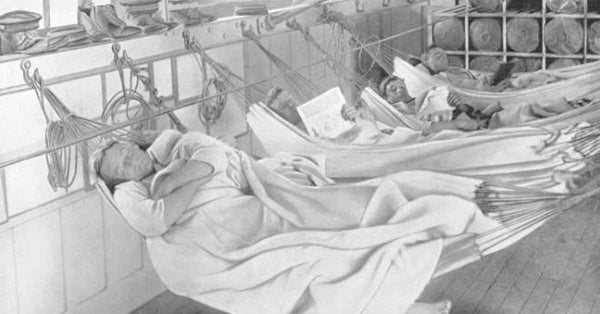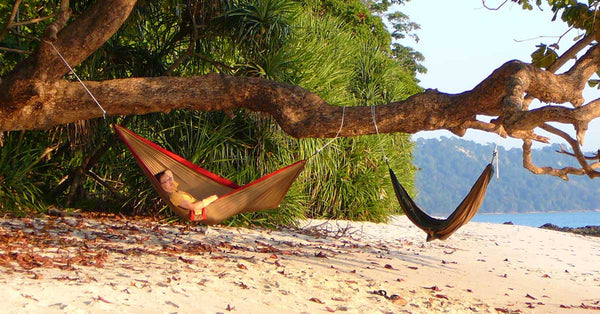
ORIGINAL HAMMOCKS
Historians trace the early beginnings of the hammock to the Mayans and Incas in Central and South America, who ingeniously crafted these suspended beds from bark or plant fibers. Archaeological finds such as votive offerings of hammocks from Colombia and Mayan pottery depicting noble personalities in hammocks offer a glimpse into its prestigious stature in ancient times. Initially made from woven bark of the Hamack Tree, they later transitioned to using sisal fibers due to its wider availability. Originating as practical sleeping solutions suspended off the ground to offer safety from dangerous creatures and insects in the warmer jungle climates, hammocks gradually transitioned into items of leisure.

HOW DID HAMMOCKS GET THEIR NAME?
Derived from the Spanish "hamacas," originating from the Taino and Arawak word 'hamaka,' the hammock has a history stretching back over a thousand years, rooted deeply in the heart of Central and South American civilizations. As Europeans adopted them, the name evolved into what we now know as the hammock or many variations across the globe. 'Hamaka' was transformed into modern German Hängematte, Swedish Hängmatta, and Dutch Hangmat, all literally meaning hanging mat.
HAMMOCKS IN THE NAVY
By the mid-16th century, European and Spanish sailors quickly recognized the hammock's merits. Its compact, hygienic, and comforting nature soon replaced the hard planks and fouling mattresses on naval ships, marking a significant milestone in maritime living standards. As the hammock sailed across the seas with the Royal Navy, its versatility shone through. Serving as space-efficient sleeping quarters during the World Wars the hammock showcased a remarkable blend of functionality and simplicity.

MODERN HAMMOCKS
Fast forward to the modern era, the hammock swings in the hearts of many as a symbol of relaxation and effortless living. The soft caress of cotton and canvas, replacing the rugged bark and sisal fibers of the past, invites one to the embrace of leisure. Today, the hammock isn't just a backyard staple but a trendy furnishing item.

Hammocks underwent a tremendous transformation in the late 20th century, transitioning from common household objects to priceless camping equipment. Innovations in materials and design accelerated this transformation. The development of strong, lightweight fabric as well as advancements in suspension techniques simplified packing a hammock alongside other camping supplies. Additionally, the 1990s and the beginning of the 2000s witnessed a rise in the popularity of specialized camping hammocks. These were now fitted with a variety of amenities made specifically for outdoor adventure, such as weather resistance, built-in mosquito netting, and insulation for colder locations.

HAMMOCK CHAIRS
During a trip to Costa Rica in 1989, Mal & BA Holtby came across a fishing net hanging from a pole that was fashioned into a chair, inspiring the invention of the hammock chair. This chair, hanging from a single point made possible by a wooden spreader bar, contrasted with the traditional two-point type hammock. They took this novel concept to Mexico's Yucatan peninsula where they worked with expert hammock weavers to improve the design. They reinvented the hammock experience by extending the net length to support the entire body and using nylon thread instead of the conventional cotton cord for increased strength and weather resistance.

Over the next 25 years, this chair hammock style proliferated throughout Yucatan and most of Mexico, becoming a staple offering among hammock manufacturers. Each presented their unique version of the chair hammock, yet none quite matched the original allure of the Hangout Chair.
SPACE HAMMOCKS
Did you know that the first beds in space were actually hammocks? Following the Apollo 11 mission, where astronauts took naps on the lunar module floor, the Apollo 12 mission innovatively introduced hammocks for better rest on the moon. These specially made space hammocks, crafted from beta cloth and adjustable with straps, provided the astronauts with softer support in the harsh lunar environment by reducing the cooling effects from contact with the cabin floor.

Today's record-breaking astronaut, Christina Hammock Koch, echoes the usefulness and comfort of hammocks in space missions. Mando from "The Mandalorian" builds a cozy hammock for Baby Yoda (Grogu) throughout their intergalactic journey, symbolizing the hammock's continuing appeal and adaptability even in the vastness of space.
ANYTHING TO ADD?
We know this is not the complete history of hammocks, but it’s the parts we do know. If you have any more information or history to add, email us at info@hamuhk.com or visit our store on Granville Island and share your hammock stories with us!
